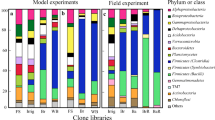Abstract
Bioremediation of DDT in soil by genetically improved recombinants of the soil fungus Fusarium solani was studied. The parent strains were isolated from soil enriched with DDD or DDE (immediate anaerobic and aerobic degradation products of DDT), as further degradation of these products are slow processes compared to the parent compound. These naturally occurring strains isolated from soil, however, are poor degraders of DDT and differed in their capability to degrade its metabolites such as DDD, DDE, DDOH and DBP and other organochlorine pesticides viz. kelthane and lindane. Synergistic effect was shown by some of these strains, when grown together in the medium containing DDD and kelthane under mixed culture condition. No synergism in DDE degradation was observed with the strains isolated from enriched soil. DDD-induced proteins extracted from individual culture filtrate (exo-enzyme) when subjected to SDS-Polyacrylamide Gel Electrophoresis (SDS-PAGE) showed complementary polypeptide bands in these strains i.e., each strain produced distinct DDD degrading polypeptide bands and the recombinant or hybrid strains produced all of the bands of the two parents and degraded DDD better than the parental strains. Recombinant hybrid strains with improved dehalogenase activity were raised by parasexual hybridisation of two such complementary isolates viz. isolate 1(P-1) and 4(P-2) showing highest complementation and are compatible for hyphal fusion inducing heterokaryosis. These strains are genetically characterised as Kel+BenRDBP-Lin- and Kel-BenrDBP+Lin+ respectively.Recombinants with mixed genotype, i.e., Kel+BenRDBP+Lin+ showing superior degradation quality for DDT were selected for bioremediation study. Recombination was confirmed by polypeptide band analysis of DDD induced exo-proteins from culture filtrate usingSDS-Polyacrylamide Gel Electrophoresis (PAGE) and RAPD (Random Amplified Polymorphic DNA) of genomic DNA using PCR (Polymerase Chain Reaction) technique. SDS-PAGE showed combination of DDD induced polypeptide bands characteristic of both the parents in the recombinants or the hybrids. PCR study showed the parent specific bands in the recombinant strains confirming gene transformation.
Similar content being viewed by others
References
Ball C (1984) Filamentous fungi. In Ball C (ed) Genetics and Breeding of Industrial Micro-organisms (pp 159–188). CRC, Boca Raton, FL
Blom RH, Pfeifer VF, Moyer AJ, Tranfler, DH & Conway, HF. (1952) Sodium gluconate production. Fermentation with Aspergillus niger. Ind. Eng. Chem. 44: 435
Bumpus JA & Aust SD (1987) Biodegradation of DDT (1,1,1-trichoro-2,2′-bis (4′-chlorophenyl) ethene) by the white rot fungus Phanerochaete chrysosporium. Appl. Environ. Microbiol. 53: 2001–2008
Bumpus JA, Tien M, Wright D & Aust SD (1985) Oxidation of persistent environmental pollutants by a white rot fungus. Science 228: 1434–1436
Castro TF & Yoshida T (1971) Degradation of organochlorine insecticides in flooded soils in Phillipines. J. Agric. Food Chem. 19: 1168–1170
Goldstein RM, Mallory M. & Alexander M. (1985) Reasons for possible failure of inoculation to enhance biodegradation. Appl. Environ. Microbiol. 50: 977–983
Guenzi WD & Beard WE (1968) Anaerobic conversion of DDT to DDD and aerobic stability of DDT in soil. Proc. Soil. Sci. Soc. Amer. 32: 522–524
Hastie AC (1981) The genetics of conidial fungi. In Cole GT and Kendrick B (eds) Biology of conidial fungi. Vol II (pp 511–547). Academic, New York
Head IM, Cain RB & Suett RD (1990) Molecular aspect of enhanced microbial degradation of pesticides. Brighton Crop Protection Conference-Pest and Diseases, pp 907–916
Katayama A & Matsumura F (1993) Degradation of organochlorine pesticides, particularly endosulfan, by Trichoderma harzianum. Environ. Toxicol. Chem. 12: 1059–1065
Laemmli UK (1970) Cleavage of structural proteins during the assembly of the head of the bacteriophage T4. Nature 227: 680–685
Leadbetter ER & Foster JW (1958) Arch Microbiol 30: 91–118
Malone TC (1970) In vitro conversion of DDT to DDD by intestinal microflora of northern anchovy, Eugraulis mordax. Nature 227: 848–849
Mitra J & Chaudhuri KL (1966) Ultraviolet induced mutation in Penicillium vermiculatum Dangeard. Trans. Bose Res. Inst. 29: 85–96
Mitra J & Raghu K (1978) Persistence of DDT in soils. Proc Symp. Nuclear techniques in studies of metabolism, effects and degradation of pesticides, DAE, Bombay, India, pp 134–142
Mitra J & Raghu K (1989) Effect of DDT on the growth of crop plants. Environ. Pollut. 61: 157–170
Mitra J & Raghu K (1998a) Long term DDT pollution in tropical soils: Effect of degradation products on soil microbial activities leading to soil fertility. Bull. Environ. Contam. Toxicol. 60: 585–591
Mitra J & Raghu K (1998b) Detrimental effects of soil residues of DDT on chillies. Fresenius Envir. Bull. 7: 8–13
Mitra J & Raghu K. (1998c) Pesticides-non-target plants interactions: An overview. Arch. Agrnomy Soil Sci. 43: 445–500
Mitra J (1999), Isolation and characterization of genetically improved DDD degrading fungi Fusarium solani through parasexual hybridization for boiremediation purposes. Proc. XXIV Annual Conference of Environmental Mutagen Soc., India, Mumbai, p 112
Nowell LH & Resek EA (1994) National standard and guidelines for pesticides in water, sediment and aquatic organisms. Application to water-quality assessments. Rev. Environ. Contam. Toxicology 140: 1–164
Thomas AW, Slater JH & Weightman AJ (1992), The dehalogenase genes dehI from Pseudomonas putida PP3 is carried on an unusual mobile genetic element designated DEH. J. Bacteriol. 174: 1932–1940
Subba Rao RV, Rubin HE & Alexander M (1982), Kinetics and extension of mineralization of organic chemicals at trace levels in fresh water and sewage. Appl. Environ. Microbiol. 43: 1139–1150.
Watanabe I. (1973) Isolation of pentachlorophenol decomposing bacteria from soil. Soil Sci. Plant Nutr. 19: 109–116.
Author information
Authors and Affiliations
Rights and permissions
About this article
Cite this article
Mitra, J., Mukherjee, P., Kale, S. et al. Bioremediation of DDT in soil by genetically improved strains of soil fungus Fusarium solani. Biodegradation 12, 235–245 (2001). https://doi.org/10.1023/A:1013117406216
Issue Date:
DOI: https://doi.org/10.1023/A:1013117406216




